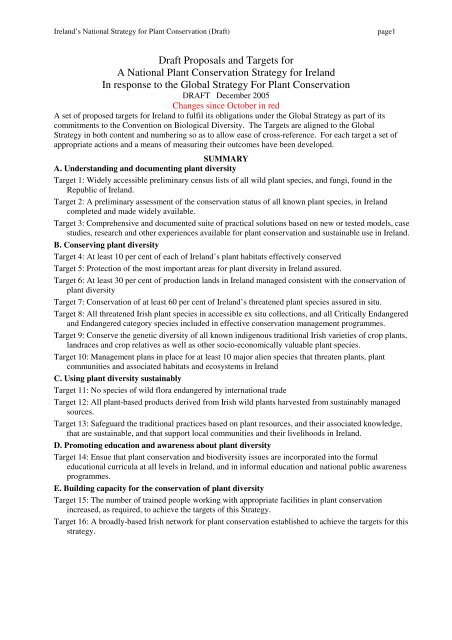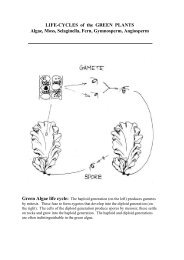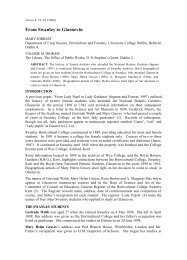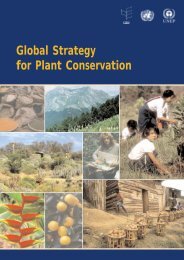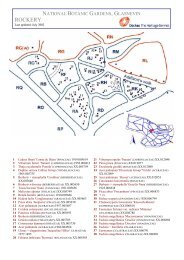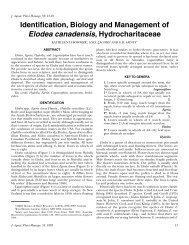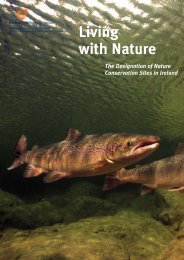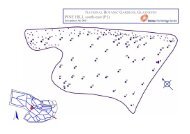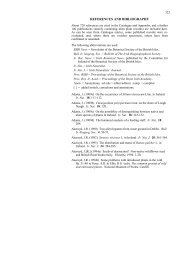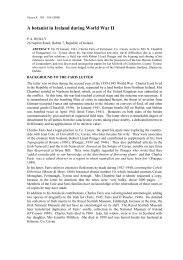National Plant Conservation Strategy for Ireland, draft (pdf)
National Plant Conservation Strategy for Ireland, draft (pdf)
National Plant Conservation Strategy for Ireland, draft (pdf)
You also want an ePaper? Increase the reach of your titles
YUMPU automatically turns print PDFs into web optimized ePapers that Google loves.
<strong>Ireland</strong>’s <strong>National</strong> <strong>Strategy</strong> <strong>for</strong> <strong>Plant</strong> <strong>Conservation</strong> (Draft)<br />
page1<br />
Draft Proposals and Targets <strong>for</strong><br />
A <strong>National</strong> <strong>Plant</strong> <strong>Conservation</strong> <strong>Strategy</strong> <strong>for</strong> <strong>Ireland</strong><br />
In response to the Global <strong>Strategy</strong> For <strong>Plant</strong> <strong>Conservation</strong><br />
DRAFT December 2005<br />
Changes since October in red<br />
A set of proposed targets <strong>for</strong> <strong>Ireland</strong> to fulfil its obligations under the Global <strong>Strategy</strong> as part of its<br />
commitments to the Convention on Biological Diversity. The Targets are aligned to the Global<br />
<strong>Strategy</strong> in both content and numbering so as to allow ease of cross-reference. For each target a set of<br />
appropriate actions and a means of measuring their outcomes have been developed.<br />
SUMMARY<br />
A. Understanding and documenting plant diversity<br />
Target 1: Widely accessible preliminary census lists of all wild plant species, and fungi, found in the<br />
Republic of <strong>Ireland</strong>.<br />
Target 2: A preliminary assessment of the conservation status of all known plant species, in <strong>Ireland</strong><br />
completed and made widely available.<br />
Target 3: Comprehensive and documented suite of practical solutions based on new or tested models, case<br />
studies, research and other experiences available <strong>for</strong> plant conservation and sustainable use in <strong>Ireland</strong>.<br />
B. Conserving plant diversity<br />
Target 4: At least 10 per cent of each of <strong>Ireland</strong>’s plant habitats effectively conserved<br />
Target 5: Protection of the most important areas <strong>for</strong> plant diversity in <strong>Ireland</strong> assured.<br />
Target 6: At least 30 per cent of production lands in <strong>Ireland</strong> managed consistent with the conservation of<br />
plant diversity<br />
Target 7: <strong>Conservation</strong> of at least 60 per cent of <strong>Ireland</strong>’s threatened plant species assured in situ.<br />
Target 8: All threatened Irish plant species in accessible ex situ collections, and all Critically Endangered<br />
and Endangered category species included in effective conservation management programmes.<br />
Target 9: Conserve the genetic diversity of all known indigenous traditional Irish varieties of crop plants,<br />
landraces and crop relatives as well as other socio-economically valuable plant species.<br />
Target 10: Management plans in place <strong>for</strong> at least 10 major alien species that threaten plants, plant<br />
communities and associated habitats and ecosystems in <strong>Ireland</strong><br />
C. Using plant diversity sustainably<br />
Target 11: No species of wild flora endangered by international trade<br />
Target 12: All plant-based products derived from Irish wild plants harvested from sustainably managed<br />
sources.<br />
Target 13: Safeguard the traditional practices based on plant resources, and their associated knowledge,<br />
that are sustainable, and that support local communities and their livelihoods in <strong>Ireland</strong>.<br />
D. Promoting education and awareness about plant diversity<br />
Target 14: Ensue that plant conservation and biodiversity issues are incorporated into the <strong>for</strong>mal<br />
educational curricula at all levels in <strong>Ireland</strong>, and in in<strong>for</strong>mal education and national public awareness<br />
programmes.<br />
E. Building capacity <strong>for</strong> the conservation of plant diversity<br />
Target 15: The number of trained people working with appropriate facilities in plant conservation<br />
increased, as required, to achieve the targets of this <strong>Strategy</strong>.<br />
Target 16: A broadly-based Irish network <strong>for</strong> plant conservation established to achieve the targets <strong>for</strong> this<br />
strategy.
<strong>Ireland</strong>’s <strong>National</strong> <strong>Strategy</strong> <strong>for</strong> <strong>Plant</strong> <strong>Conservation</strong> (Draft)<br />
page2<br />
<br />
Target 1: Widely accessible preliminary census lists of all wild plant species, and fungi, found in<br />
<strong>Ireland</strong>.<br />
Actions:<br />
Many of the actions <strong>for</strong> this target need to be undertaken in collaboration with the appropriate<br />
bodies in Northern <strong>Ireland</strong>. It is envisaged that checklists would be provided, as a starting point,<br />
and as Census catalogues became available electronically they could be updated to the <strong>National</strong><br />
GSPC website. This target will contribute to action 41 of the <strong>National</strong> Biodiversity Plan.<br />
Current state of knowledge of <strong>Plant</strong> & Fungi species in <strong>Ireland</strong><br />
GROUP Taxa Checklist Census Cat.<br />
FUNGI 3,500 2005 <br />
FUNGI-Lichens 957 1984<br />
FUNGI-Lichenicolous species 150 2002<br />
ALGAE-Freshwater 1,000+ <br />
ALGAE-Marine 579 2005 <br />
BRYOPHYTES 815 2004<br />
PTERIDOPHYTES 78 1987<br />
SEED PLANTS - Native 815 1987<br />
SEED PLANTS - Aliens 1,108 2002<br />
Gather, compile and facilitate access to publications and in<strong>for</strong>mation relevant to <strong>Ireland</strong>’s flora.<br />
Provide access to synonym lists <strong>for</strong> all plant (vascular, bryophytes by 2006; algae by 2008) and<br />
fungi species (by 2007).<br />
Update the Census Catalogue of Vascular <strong>Plant</strong>s by 2008; investigate GBIF protocols in respect of<br />
data holdings; develop an on-line Census Catalogue.<br />
Update the Census Catalogue of Lichens by 2007<br />
Produce Census Catalogue of Marine Algae by 2007<br />
Develop a Checklist of Fungi by 2007<br />
Develop a Census Catalogue of Fungi by 2009<br />
Milestones & Indicators:<br />
Census Catalogue of Bryophytes is complete (2004)<br />
Preliminary Checklists of all plant and fungi species available on the website by 2006.<br />
Census Catalogue of vascular plants available on-line by 2007<br />
Preliminary Census Catalogue of Lichens & Fungi available on-line by 2007<br />
Preliminary Census Catalogue of Marine & Freshwater algae available on-line by 2007<br />
<br />
Target 2: A preliminary assessment of the conservation status of all known plant species in<br />
<strong>Ireland</strong> completed and made widely available.<br />
Wildlife Service is currently sponsoring endangered Bryophyte surveys of a number of vice<br />
counties each year. A database of all threatened plants is currently being completed by Wildlife.<br />
Actions:<br />
Develop a working Red data list of vascular plants, to be put on-line <strong>for</strong> public consultation<br />
Test Comparison of ca. 6 species of vascular plants to judge +/- overlap of data between BSBI VC<br />
recorders and NPWS dataset; A Gap-analysis Workshop to be undertaken in October 2006 to<br />
further refine red data list.
<strong>Ireland</strong>’s <strong>National</strong> <strong>Strategy</strong> <strong>for</strong> <strong>Plant</strong> <strong>Conservation</strong> (Draft)<br />
page3<br />
To encourage, and facilitate the publication of new records where action needs to be taken in<br />
protecting new sites <strong>for</strong> species of conservation concern<br />
Establish a national database on rare and scarce plants by 2007<br />
Preliminary assessment of the conservation status of algae by 2008<br />
Preliminary assessment of the conservation status of lichens and fungi by 2009<br />
Milestones & Indicators:<br />
Provide the full text of the previous Red Data Book on the website (Done)<br />
Publication of an updated Red Data List of bryophytes by 2010<br />
Publication of Red Data List of vascular plants, by 2010<br />
<br />
Target 3: Comprehensive and documented suite of practical solutions based on new or tested<br />
models, case studies, research and other experiences available <strong>for</strong> plant conservation and<br />
sustainable use in <strong>Ireland</strong>.<br />
The intention under this target is to provide a clearing house of practical guidance on how to<br />
conduct plant conservation and sustainable use activities in particular settings in <strong>Ireland</strong>.<br />
Techniques, technologies, protocols, practices, models, experiences and other <strong>for</strong>ms of case<br />
studies will be compiled so as to have a source of practical in<strong>for</strong>mation. This is an important<br />
cross-cutting target and supports a number of actions of the <strong>National</strong> Biodiversity Plan, including<br />
actions 18, 29, 34, 35, 40, 43, 44, 66, 75, 80, 81, and 84.<br />
Actions:<br />
Develop a national plant research agenda through a consultative process and set priorities.<br />
Locate all research publications from the past 25 years on threatened plant ecology, biology and<br />
other conservation studies. Road building, Golf-course construction, Hedge management and any<br />
EIA proposals <strong>for</strong> amelioration or mitigation and actual outcomes should be included.<br />
Compile existing management advice from Environmental NGOs, Government bodies and other<br />
organisations, and place on website.<br />
Undertake research to investigate the most effective range of techniques available <strong>for</strong> plant<br />
conservation, including seedbanks, translocations, habitat manipulation and management, genetic<br />
diversity studies, pollination biology etc., to be completed by 2006. This should include bryophyte<br />
and lichen conservation, in additional to vascular plants.<br />
Milestones & Indicators:<br />
Provide an on-line set of published guidelines, techniques, protocols searchable by taxon and<br />
habitat.<br />
Provide an on-line set of (or links to) guidelines <strong>for</strong> suitable management practices and techniques<br />
<strong>for</strong> woodland, ponds, hedgerows etc.<br />
Develop guidelines <strong>for</strong> the incorporation of plant conservation targets into local authority area<br />
development plans, local area Biodiversity Action Plans, Agri-environmental schemes, Site<br />
Management Plans.<br />
Produce a manual <strong>for</strong> practical plant conservation in <strong>Ireland</strong> by 2007<br />
Produce guidelines <strong>for</strong> county councils local authorities <strong>for</strong> restoration and rehabilitation of<br />
threatened species and associated habitats, Motorway and Trunk road verges rehabilitation.
<strong>Ireland</strong>’s <strong>National</strong> <strong>Strategy</strong> <strong>for</strong> <strong>Plant</strong> <strong>Conservation</strong> (Draft)<br />
page4<br />
B. Conserving plant diversity<br />
<br />
Target 4: At least 10 per cent of each of <strong>Ireland</strong>’s plant habitats effectively conserved<br />
This target supports actions 31 and 78 of the <strong>National</strong> Biodiversity Plan, and specifically looks at<br />
conserving habitats rather than species.<br />
Actions:<br />
<strong>Ireland</strong>s national resources and habitats fully mapped by 2009.<br />
Assess the congruence of plant habitats and conservation areas already under legal protection.<br />
Habitat Action Plans to be developed <strong>for</strong> those habitats <strong>for</strong> which <strong>Ireland</strong> has special responsibility<br />
(ca. 10-15 habitats, i.e. Charophytic lakes, Alpine heathland) by 2010.<br />
Ascertain the coverage of <strong>Ireland</strong>’s habitat diversity. Estimate the national resource of ecological<br />
regions and habitats in areas protected under the European Communities (Natural Habitats)<br />
Regulations, 1997 (NATURA 2000 network) and the Wildlife (Amendment) Act, 2000, e.g.<br />
SACs, designated NHAs and <strong>National</strong> Nature Reserves by 2009, with a view to filling any gaps in<br />
coverage by 2010<br />
Incorporate plant conservation issues in County Council Biodiversity Action Plans local authority<br />
area development plans, local area Biodiversity Action Plans, Agri-environmental schemes (e.g.<br />
REPs, CFPs, NPWSFPs).<br />
Milestones & Indicators:<br />
Publish an assessment of how well <strong>Ireland</strong>’s habitats are legally protected.<br />
New protected areas or extension of existing areas achieved where necessary.<br />
<br />
Target 5: Protection of the most important areas <strong>for</strong> plant diversity assured.<br />
An initial process will be to identify areas within <strong>Ireland</strong> that are significant in terms of the plant<br />
or fungal species or combinations of plants and fungi contained within them. Drafting and<br />
designation of these regions will be an important step in appreciating gaps in other legal<br />
approaches to the protection of our flora.<br />
Actions:<br />
Develop methodology and criteria <strong>for</strong> recognising Important Areas <strong>for</strong> <strong>Plant</strong> Diversity in the<br />
Republic of <strong>Ireland</strong> by July 2006.<br />
Undertake 3 pilot studies which will identify Important Areas <strong>for</strong> <strong>Plant</strong> Diversity in Dublin<br />
(DNFC), Westmeath (Con Breen), and East Galway (GNFC) by October 2006.<br />
Presentation of results of pilot studies at a meeting in September 2006, at which the methodology<br />
and criteria will also be refined.<br />
Identification of important areas of vascular plant diversity by 2007.<br />
Determine the extent to which important areas of plant diversity fall within protected areas, e.g.<br />
SACs, NHAs and <strong>National</strong> Nature Reserves, with a view to filling any gaps in coverage by 2010.<br />
Milestones: & Indicators:<br />
Disseminate in<strong>for</strong>mation on the significance and conservation value of IAPDs in the <strong>for</strong>m of a<br />
publication based on the three Pilot studies, and launch a <strong>National</strong> Initiative.<br />
Evaluate the extent to which IAPDs fall within protected (designated) areas, and publish a report<br />
on the extent to which important areas of plant diversity fall within <strong>for</strong>mally protected areas.
<strong>Ireland</strong>’s <strong>National</strong> <strong>Strategy</strong> <strong>for</strong> <strong>Plant</strong> <strong>Conservation</strong> (Draft)<br />
page5<br />
<br />
Target 6: At least 30 per cent of production lands managed consistent with the conservation of<br />
plant diversity<br />
This target is subject to the changing activities of EU agricultural interventions such as REPs<br />
payments and other farming subsidies. In the <strong>for</strong>estry sector there has already been a major shift<br />
from timber production to woodland creation in such projects as the Peoples Millennium Forests<br />
Project and the Native Woodland Scheme. The achievements of Target 3 will provide a valuable<br />
resource <strong>for</strong> this target also. Actions 20, 21, 23, 32, 33, 66 and 67 of the <strong>National</strong> Biodiversity<br />
Plan address these issues also.<br />
Actions:<br />
Mechanism and funding in place to secure in situ conservation of Irish agricultural plant genetic<br />
resources and their associated weeds.<br />
Provision of resources and guidelines <strong>for</strong> hedge management and marginal lands developed.<br />
Make recommendations from hedgerow survey reports widely available<br />
Improvement of REPS and development of appropriate NPWS farm plans<br />
Milestones & Indicators:<br />
No further declines in Irish agricultural weeds.<br />
Assessment of the effectiveness of the Linnet Project <strong>for</strong> conserving vascular plant species<br />
associated with agriculture.<br />
Compliance of farmers and successful implementation of REPS<br />
Linkages into other agri-biodiversity schemes.<br />
<br />
Target 7: <strong>Conservation</strong> of at least 60 per cent of <strong>Ireland</strong>’s threatened plant species assured in<br />
situ.<br />
Protected areas provide the only current means of conservation. Public awareness and landowner<br />
co-operation are potentially valuable avenues to explore. Actions 21, 22, 23 & 24 of the <strong>National</strong><br />
Biodiversity Plan cover monitoring and assessment of protected area legislation.<br />
Actions:<br />
Determine congruence of threatened plants and existing legally protected areas by 2008.<br />
Develop species management plans <strong>for</strong> the most critically endangered species.<br />
Implement a national research programme in the conservation biology of threatened plants.<br />
Milestones & Indicators<br />
Publish detailed distribution in<strong>for</strong>mation on protected and threatened plants, where appropriate, to<br />
prevent inadvertent loss or destruction of species through ignorance.<br />
Ensure that all threatened species of the Irish Flora occur in protected areas.<br />
<br />
Target 8: All threatened plant species in accessible ex situ collections, and all Critically<br />
Endangered and Endangered category species included in effective conservation<br />
management programmes.<br />
A recent project launched by <strong>Plant</strong>Network: the <strong>Plant</strong> Collections Network of Britain and <strong>Ireland</strong><br />
has prepared a set of eight sub-targets in order to develop three major goals: a complete database<br />
of cultivation and propagation protocols <strong>for</strong> all the threatened plant species of Britain and <strong>Ireland</strong>;<br />
<strong>for</strong>mation of partnerships between ex situ and in situ conservation ef<strong>for</strong>ts, through developing
<strong>Ireland</strong>’s <strong>National</strong> <strong>Strategy</strong> <strong>for</strong> <strong>Plant</strong> <strong>Conservation</strong> (Draft)<br />
page6<br />
horticultural knowledge of these species; and lastly to increase the number of species in cultivation<br />
so as to provide material <strong>for</strong> experimental or public awareness programmes.<br />
Actions:<br />
Establish a national database of ex situ collections of threatened plants, by 2008.<br />
Initiate Species Action Plans <strong>for</strong> all Red Data Book Species in <strong>Ireland</strong> by 2008.<br />
Where required, all critically endangered vascular plant taxa included in species recovery<br />
programmes.<br />
All internationally threatened vascular plants, including all those of EU concern, to be the subject<br />
of active and on-going monitoring programmes by 2008, with recovery programmes <strong>for</strong> any that<br />
are deemed necessary to be initiated by 2010.<br />
Ensure 60% of accessions in the Irish Threatened <strong>Plant</strong> Genebank have the minimum requirements<br />
<strong>for</strong> active base collections, by 2010.<br />
Extend the coverage of the Irish Threatened <strong>Plant</strong> Genebank to contain 3-5 accessions (where<br />
possible) of all threatened and scarce Irish native plants.<br />
An integrated project to cultivate all the threatened species of vascular plant in <strong>Ireland</strong> at botanical<br />
collections, and to collate, and synthesise appropriate cultivation and propagation protocols <strong>for</strong> all<br />
these species.<br />
Determine effective methods <strong>for</strong> bryophyte conservation by 2010, and begin the implementation<br />
of monitoring and recovery plans <strong>for</strong> 10% of threatened Irish bryophytes by 2010.<br />
Milestones & Indicators:<br />
Species management plans in place <strong>for</strong> all CR, EN and EW category plant species in <strong>Ireland</strong>.<br />
All threatened vascular plants, where appropriate and possible, accessioned in the Irish Threatened<br />
<strong>Plant</strong> Genebank, with a minimum of 3 accessions each.<br />
Complete inventory of cultivation and propagation protocols <strong>for</strong> all <strong>Ireland</strong>’s threatened vascular<br />
plants, as a complementary measure to the seed bank.<br />
Species management and monitoring programmes in place <strong>for</strong> all internationally threatened native<br />
vascular plants, particularly those of EU concern.<br />
<br />
Target 9: Conserve the genetic diversity of all known indigenous traditional Irish agricultural<br />
plant varieties of crops, land races and crop relatives as well as other socio-economically<br />
valuable plant species.<br />
Many agricultural crops being bred in <strong>Ireland</strong> today supply a rather small and specialist market<br />
including malting Barleys and sugar beet. By targeting heritage crops and vegetables there will be<br />
some ability to document and secure these varieties. The genetic integrity of these agriculturally<br />
important species have also been addressed under action 35 of the <strong>National</strong> Biodiversity Plan.<br />
Actions:<br />
Develop a checklist of all traditional Irish-bred agricultural plant varieties and circulate to holders<br />
of ex situ collections <strong>for</strong> comments, additions and to mark materials held.<br />
Further collate all existing knowledge on traditional Irish use of plant genetic resources and ensure<br />
that this material is effectively archived.<br />
Ensure continued survival of Irish agricultural plant genetic resources in one or more genebanks<br />
within the State by 2007.<br />
Establish a <strong>National</strong> Heritage Grain Crops programme to promote the growing of a number of<br />
Irish bred grain varieties on farms <strong>for</strong> use in novel or traditional crops (Biomass, Thatching).
<strong>Ireland</strong>’s <strong>National</strong> <strong>Strategy</strong> <strong>for</strong> <strong>Plant</strong> <strong>Conservation</strong> (Draft)<br />
page7<br />
Promote the continued use of crop varieties and landraces in traditional Irish agricultural systems<br />
by developing new incentive mechanisms <strong>for</strong> farmers by 2011.<br />
Develop an Irish Cultivars school projects <strong>for</strong> Primary (Vegetable) and Secondary (Grain crops)<br />
School level. Establish a pilot project in schools to raise awareness of indigenous agricultural<br />
biodiversity.<br />
Encourage each Local Authority to incorporate a Community Orchard of traditional Irish bred<br />
apple, pear, plum and damson varieties in their Local Biodiversity Action Plans. Each Community<br />
Orchard should be at least 500m2 and comprise a minimum of 20 trees of 10 or more varieties.<br />
Develop and write leaflets <strong>for</strong> gardening clubs and farming organisations promoting the growing<br />
of heritage grain and vegetable varieties by 2008.<br />
Milestones & Indicators:<br />
Database of all known Irish-bred agricultural plant varieties, and their location in living or other<br />
collections published and widely available.<br />
Five Heritage Grain Crops established in an incentivised scheme by 2011.<br />
Sixteen Local Authorities to have incorporated a Community Orchard in their Local Biodiversity<br />
Plan.<br />
Establish a pilot project in schools to raise awareness of indigenous agricultural biodiversity.<br />
<br />
Target 10: Management plans in place <strong>for</strong> at least 10 major alien species that threaten plants,<br />
plant communities and associated habitats and ecosystems in <strong>Ireland</strong><br />
Alien plants have had a relatively small impact in <strong>Ireland</strong>, but globally they represent a serious<br />
threat to biodiversity. At present rhododendron is one of the few plants <strong>for</strong> which serious ef<strong>for</strong>ts<br />
are being made to control its population, but eradication is seen as impossible. The Global<br />
Invasive Species Programme (GISP) and Invasive Species Specialist Group (ISSG) have<br />
<strong>for</strong>mulated guidelines <strong>for</strong> developing national management plans. The only serious action to an<br />
invasive alien is total eradication, this may still be achievable with some, but is probably<br />
impossible with others. Introduction of <strong>for</strong>eign genepool material in ‘Wild Flower’ seed mixes is<br />
another cause <strong>for</strong> concern.<br />
Actions:<br />
Draft new lists of prohibited weeds in consultation with Northern authorities to ban the sale,<br />
introduction, release or movement, especially of aquatics. Maintain vigilance on emerging threats.<br />
Review of national phytosanitary legislation to be harmonized with international and regional<br />
provisions by 2006<br />
Develop priority list of 10-12 species; Implement efficient management programmes and Species<br />
Action Plans <strong>for</strong> at least 10 established invasive plant species by 2008.<br />
Develop and implement mechanisms <strong>for</strong> early detection and rapid action against potentially new<br />
invasive species including a manual of procedures <strong>for</strong> border control by 2007. Prepare documents<br />
<strong>for</strong> horticulturists to enable guidelines to be developed to prevent the establishment of new<br />
invasive aliens in the country.<br />
Evaluate existing all-<strong>Ireland</strong> Species Action Plans <strong>for</strong> Alien species, and modify as appropriate, by<br />
2009.<br />
Assess and monitor the risk of genetic pollution of native plant species and populations from<br />
introductions of <strong>for</strong>eign ‘Wild Flower seed’ by 2009.<br />
Milestones & Indicators:
<strong>Ireland</strong>’s <strong>National</strong> <strong>Strategy</strong> <strong>for</strong> <strong>Plant</strong> <strong>Conservation</strong> (Draft)<br />
page8<br />
Develop an efficient target-10 webpage, as part of the GSPC page, which will co-ordinate actions<br />
and organisations in highlighting or controlling problem species.<br />
Leaflets warning of the dangers of alien plants especially aquatics such as Crassula helmsii.<br />
Noxious Weeds act extended to cover an increased number of prohibited species.<br />
Hydrocotyle ranunculoides exterminated in its two localities.<br />
C. Using plant diversity sustainably<br />
<br />
Target 11: No species of wild flora endangered by international trade<br />
The <strong>National</strong> Biodiversity Plan has a single action to increase training and capacity (action 27) <strong>for</strong><br />
border control, and its impact on international trade. Action 53 of the <strong>National</strong> Biodiversity Plan<br />
specifically allocates 6 million to overseas initiatives.<br />
Actions:<br />
Initiate a research programme to determine the extent of trade in wild flora into and out of <strong>Ireland</strong><br />
to be completed by 2008.<br />
Develop a policy and enact legislation <strong>for</strong> access and benefit sharing by 2007.<br />
Develop resources to highlight the economic impact of horticulture, herbal medicine, floristry etc.<br />
on international plant conservation issues.<br />
Milestones & Indicators:<br />
ABS legislation enacted to support plant conservation initiatives internationally.<br />
Overseas Development Agency spends 5 million on plant conservation and sustainable usage of<br />
plant-resources as part of its programme.<br />
30 per cent of plant-based products arriving from outside <strong>Ireland</strong> derived from sources that are<br />
sustainably managed, and whose environmental impacts are minimised.<br />
100 per cent of Public procurement of plant based products arriving from outside <strong>Ireland</strong> derived<br />
from sustainably managed sources.<br />
<br />
Target 12: All plant-based products derived from Irish wild plants harvested from sustainably<br />
managed sources.<br />
Actions:<br />
Initiate a research programme to determine the usage of plant-based products arising from within<br />
and outside of <strong>Ireland</strong>, to be completed by 2008.<br />
Guidelines developed <strong>for</strong> smallholder turf cutting.<br />
Milestones & Indicators:<br />
90% of plant-based products, other than peat, produced within <strong>Ireland</strong>, derived from sources that<br />
are sustainably managed.<br />
Target 13: Safeguard the traditional practices based on plant resources, and their associated<br />
knowledge, that support local communities and their livelihoods in <strong>Ireland</strong>.<br />
Actions:<br />
Develop a checklist of archived materials and ethnographic records covering traditional practices<br />
with reference to plant materials.
<strong>Ireland</strong>’s <strong>National</strong> <strong>Strategy</strong> <strong>for</strong> <strong>Plant</strong> <strong>Conservation</strong> (Draft)<br />
page9<br />
Develop links with existing groups, including the Irish basket-makers association, the Hedge-<br />
Laying Society of <strong>Ireland</strong>, the Coppice Association of <strong>Ireland</strong>, the Thatchers guild, etc. to<br />
determine the degree to which these practices are surviving.<br />
Develop a school project to encourage Transition Year students to collect in<strong>for</strong>mation from<br />
in<strong>for</strong>mants on agricultural or rural practices and traditions in the first half of the 20 th Century or<br />
earlier. A teacher’s pack and background literature would be prepared and distributed.<br />
Discuss with the Heritage Council the possibility of publishing a call <strong>for</strong> proposals <strong>for</strong> local<br />
projects on plant folklore etc.<br />
Milestones & Indicators:<br />
Web-based checklist of archive material made available, perhaps as a bibliography<br />
D: Promoting education & awareness about plant diversity<br />
<br />
Target 14: Ensure that plant conservation and biodiversity issues are incorporated into the<br />
<strong>for</strong>mal educational curricula at all levels, and in in<strong>for</strong>mal education and national public<br />
awareness programmes.<br />
A major goal <strong>for</strong> this target is to have an efficient Clearing House Mechanism to act as the focal<br />
point <strong>for</strong> the Global <strong>Strategy</strong> <strong>for</strong> <strong>Plant</strong> <strong>Conservation</strong> (see www.botanicgardens.ie/herb/census/<br />
resource). Much of the materials <strong>for</strong> this website already exist, different levels <strong>for</strong> engaging the<br />
public will be vital, and could be used as a teaching resource <strong>for</strong> Primary and secondary level<br />
pupils. To identify where plant conservation issues arise in national curricula, and if not why not;<br />
if they do, then flag these up and make them more prominent.<br />
Actions:<br />
Regular programmes and articles produced in the national media to highlight the importance of<br />
native plants in local ecosystems.<br />
Presentations and/or workshops about plant conservation to be held regularly, including<br />
in<strong>for</strong>mation on native plants, plant genetic resources, invasive species and control measures<br />
Ensure that plant conservation and biodiversity issues are incorporated within the <strong>for</strong>mal education<br />
curricula and in<strong>for</strong>mal education, including extra-curricular activities by 2010.<br />
Develop resources <strong>for</strong> primary school teachers to provide interactive and captivating materials.<br />
Native plant ecology incorporated in secondary & post secondary curricula<br />
Develop resources to promote Irish plant diversity, the ecosystem value and goods provided, by<br />
2008.<br />
Milestones & Indicators:<br />
20% of schools visited by an education officer by 2010, and regularly thereafter.<br />
Every secondary school student should visit the <strong>National</strong> Botanic Gardens at least once by 2010.<br />
Publish and distribute Leaflets <strong>for</strong> Gardening clubs and Farming organisations promoting the<br />
growing of heritage grain and vegetable varieties by 2008.<br />
A series of leaflets on themes, such as carnivorous plants, crop relatives etc. by 2008. Teagasc<br />
would be amenable to disseminating these and incorporating their logo.<br />
Publish and distribute resources <strong>for</strong> primary school teachers <strong>for</strong> local plant identification and basic<br />
botany.<br />
Training opportunities in plant ecology and conservation provided <strong>for</strong> the general public through<br />
vocational training
<strong>Ireland</strong>’s <strong>National</strong> <strong>Strategy</strong> <strong>for</strong> <strong>Plant</strong> <strong>Conservation</strong> (Draft)<br />
page10<br />
Publish and distribute widely resources to promote Irish plant diversity, to the Irish public and to<br />
tourists visiting <strong>Ireland</strong> by 2008<br />
Establish a Clearing House website to provide access to in<strong>for</strong>mation on Targets 1 to 13 of this<br />
strategy, by 2007.<br />
E. Building capacity <strong>for</strong> the conservation of plant diversity<br />
<br />
Target 15: The number of trained people working with appropriate facilities in plant<br />
conservation increased, as required, to achieve the targets of this <strong>Strategy</strong>.<br />
Actions:<br />
The number of trained people working with appropriate facilities in plant conservation increased,<br />
according to national needs, to achieve the targets of this <strong>Strategy</strong>.<br />
Complete a study on the financial needs <strong>for</strong> the achievement of the <strong>National</strong> <strong>Plant</strong> <strong>Conservation</strong><br />
<strong>Strategy</strong> by 2005.<br />
Implementation of the <strong>National</strong> Biodiversity Plan, promotion of the aims of this plan, and the<br />
Global <strong>Strategy</strong> <strong>for</strong> <strong>Plant</strong> <strong>Conservation</strong> at political level.<br />
Improve capacity amongst government, the NGO, university, industry, voluntary and private<br />
sectors, to implement the <strong>National</strong> <strong>Plant</strong> <strong>Conservation</strong> <strong>Strategy</strong> and achieve its targets, by 2010.<br />
Improve communication between plant recorders and decision makers in the interests of plant<br />
conservation.<br />
Promote careers in <strong>Plant</strong> Sciences<br />
At least double the existing or available funds <strong>for</strong> plant conservation from government and private<br />
sectors.<br />
Conduct a review of Taxonomic needs in the country.<br />
Improve the facilities and increase the capacity of the Irish Threatened <strong>Plant</strong> Genebank, Irish<br />
Seedsavers, and Genetic Heritage <strong>Ireland</strong> to include difficult species groups and regular viability<br />
testing, by 2008.<br />
Milestones & Indicators:<br />
Ensure that a proportion of national biodiversity research funding to be implemented under action<br />
44 of the <strong>National</strong> Biodiversity Plan and currently being promoted by the NPBR be used to train<br />
postgraduate students in plant conservation biology.<br />
Increased capacity <strong>for</strong> third level institutions to undertake plant conservation research in<br />
partnership with relevant state agencies.<br />
Establish lectureships/chairs in 3rd level institutions to undertake plant conservation biology<br />
research and teaching.<br />
Increase the number of research staff at NPWS dealing with plant conservation.<br />
<br />
Target 16: Broadly based Irish network <strong>for</strong> plant conservation established to achieve the targets<br />
<strong>for</strong> this strategy.<br />
Actions:<br />
Establish a grouping to <strong>draft</strong> codes of conduct <strong>for</strong> promoting best practice in Irish Horticulture.<br />
Co-ordinate and oversee plant conservation activities within <strong>Ireland</strong>.<br />
Establish representation from <strong>Ireland</strong> in European and International networks, and disseminate<br />
in<strong>for</strong>mation to the wider <strong>Plant</strong> Sciences community.
<strong>Ireland</strong>’s <strong>National</strong> <strong>Strategy</strong> <strong>for</strong> <strong>Plant</strong> <strong>Conservation</strong> (Draft)<br />
page11<br />
Milestones & Indicators:<br />
Establish a webpage (www.botanicgardens.ie/gspc.htm)giving up to date progress on the targets in<br />
this strategy, as well as news and current activities in <strong>Plant</strong> conservation in <strong>Ireland</strong> generally.<br />
Network set up and holding regular meetings, and with an agreed programme of work, by 2007<br />
2006 meeting of Network to look at Important Areas <strong>for</strong> <strong>Plant</strong> Diversity pilot studies, a<br />
preliminary Red Data List, and review other targets.


